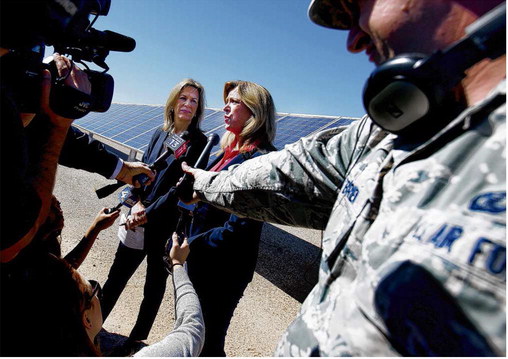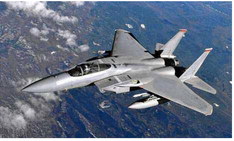AF secretary: D-M's future maybe found beyond A-10s
Base has received strong local support, but cuts still loom
By Emily Bregel
ARIZONA DAILY STAR
As Davis-Monthan Air Force Base faces dual threats of cuts to its primary mission - its fleet of A-10 close-air support jets - and the specter of base closures nationally, Air Force Secretary Deborah Lee James said its'future is bright.'
'I couldn't be more impressed with what I have seen so far,' she told local reporters on Wednesday, during her first visit to D-M. 'This is a very, very busy base.'
James praised the A-10 mission here and said proposals to retire the fleet nationally were rooted in budget constraints. She pointed to D-M's new drone unit, which remotely flies MQ-1 Predator drones, and nearby training areas as platforms for expansion.
'I think there's room for growth, in terms of missions' at D-M, she said.
James' whirlwind visit to Tucson comes as D-M supporters tout a new survey showing strong local support for the base and for the controversial prospect of high-decibel F-35sflying more frequently in Southern Arizona.
Meanwhile, opponents of increasingly loud jets passing through Tucson airspace have become more vocal.
In January, the Arizona Center for Law in the Public Interest and three neighbors of the base filed a lawsuit in U.S. District Court of Arizona against the Air Force. The suit challenges an environmental
See SUPPORT, A4

Air Force Secretary Deborah Lee James, center right, and Deputy Secretary of Energy Elizabeth Sherwood-Randall visit the base.
MIKE CHRISTY / ARIZONA DAILY STAR
Continued from Page A1
assessment that concluded there would be 'no significant impact' from a dramatic expansion planned for D-M's pilot training programs.
The suit seeks to compel the Air Force to do a more thorough environmental study, in compliance with the National Environmental Policy Act, to realistically gauge the noise and health impacts of the program on D-M's neighbors.
James said Wednesday she was aware of the lawsuit but hadn't studied it in detail.
'The Air Force is working with the Department of Justice to determine the legal approach going forward,' she said.
The secretary's visit, which also included Deputy Secretary of Energy Elizabeth Sherwood-Randall, took place at one of D-M's two massive solar-array sites, which boast 57,000 solar panels.
Built in 2013, the solar installation now provides 38 percent of D-M's power and saves the base about $500,000 each year in energy costs.
HERITAGE FLIGHT
Amid the criticism and celebration of D-M, classic World War II warbirds, Korean War-era fighters and modern attack jets danced across the sky last weekend, to the delight of spectators who glimpsed the private training event held at the base.
D-M's annual Heritage Flight trains and certifies pilots to fly alongside vintage airplanes in air shows. The event gave Tucsonans their first extended exposure to the F-35, the military's newest fighter jet.
The Air Force has said it would replace A-10s nationally with F-35 Lightning II stealth fighters and will decide 'squadron by squadron' who gets them. So far, D-M has been passed over. The Air Force's most recent plan shows D-M acquiring 21 F-16 Fighting Falcon jet fighters in fiscal year 2020.
D-M got a handful of complaints related to noise or aircraft flying too low but otherwise, the response was 'overwhelmingly positive,' said Capt. Casey Osborne, chief of public affairs for the 355th Fighter Wing at D-M.
Tucson native Lisa Downey, a project manager for a construction company, spent her Saturday with a group of spectators gathered on a dirt lot south of the base. Armed with a cooler and a radio scanner, they watched the aircraft take off and listened in on chatter from the D-M control tower.
Downey said she got chills watching - and feeling - the F-35s.
'When they take off and they shoot straight up, it's like a shockwave,' said Downey, 42, whose cousin does munitions work on A-10s at D-M. 'You can feel that thunder.'
The thrill remained after the aircraft landed.
'I had the best dreams Saturday night. It was all jets, all night,' Downey said. 'I didn't want to wake up.'
OPPOSITION TO F-35
For others, the thunderous attack jets are more like a nightmare.
The possibility that an F-35 squadron could one day replace Tucson's A-10 Thunderbolt II jets - which are quiet in comparison has dismayed Tucsonans concerned about noise and safety. At takeoff, the F-35 is about nine decibels louder than the most powerful version of the F-16, Air Force data show. Ten decibels equates to about a doubling in perceived noise.
Even strong military supporters have qualms with the F-35, which has been riddled with design problems and criticized for its exorbitant cost. Sens.
John McCain and Martha McSally say it's an inadequate replacement for the steadfast A-10, known as the 'Warthog,' which can fly low and slow, providing critical close-air support to ground troops.
The Air Force has agreed to delay the phase-out of the A-10, but the Warthog is on borrowed time.
In February the Air Force said it would begin the phase-out in fall of 2018, as part of a plan to completely mothball the fleet by 2022. Also in fiscal year 2019, Davis- Monthan is expected to lose six of its 14 EC-130H Compass Call electronic- warfare planes.
LAWSUIT
F-35s aren't the only loud jets garnering controversy.
The continual expansion of D-M's visiting-pilot training program - known as Total Force Training has brought louder planes to Tucson, including the F-15 and F-18, and will dramatically increase the number of sorties flying out of Davis-Monthan, according to the lawsuit contesting the finding of 'no significant impact' from the expansion.
Julia Keen Neighborhood resident Rita Ornelas is one of the plaintiffs in the suit. She says the increasingly louder jets are damaging her health and her home, where fly-overs have resulted in cracked windows.
An F-22 flew directly over her home during an air show a few years ago and Ornelas felt the vibrations from her head to her toes. Heart racing, Ornelas said she felt she was having a nervous breakdown.
'I was paralyzed in my tracks just seeing it, the noise of it and the feeling of it,' she said.
With limited finances, Ornelas said she wishes she could relocate but she can't afford to move from her home of 30 years. She feels that D-M isn't hearing the concerns of its closest neighbors.
'We support the base, but we support them with responsible missions,' she said. 'Nobody wants to see the base closed.'
PRESSURE ON D-M
The impending cuts have heightened pressure on D-M to secure a new mission independent of the A-10 and prove its worth to the Air Force, which is looking for bases to close in the next few years.
The Air Force now has more capacity than it needs and could conduct another Base Realignment and Closure process, known as BRAC, as early as 2017.
'The reality is, the Air Force has 90,000 less airmen than it did 20 years ago and it has too much infrastructure,' said Brian Harpel, president of the nonprofit DM50, a Tucson- based advocacy group for D-M. 'That's a potential threat somewhere over the horizon and we need to be prepared for that.'
Davis-Monthan has a lot going for it, in addition to its sheer breadth of airspace and predictable weather, supporters say. D-M's proximity to the Barry M. Goldwater Air Force Range makes it an ideal spot for training operations. The base is also home to 'the Boneyard,' the Air Force's primary storage, maintenance and parts facility with an inventory of more than 4,200 aircraft and 40 aerospace vehicles. Supporters must rally around the base, which generates $1 billion per year for Tucson's economy, Harpel said.
'D-M has best weather, range and airspace of any Air Force base in the United States,' he said. 'That's an important message to get out to the Air Force and Congress on why D-M is so important, not only to our national security but also our local economy.'
LOCAL SUPPORT STRONG
DM50 and another pro-military group, Southern Arizona Defense Alliance, just released their latest survey showing robust support locally both for the base and the proposal to bring F-35 fighter jets here. The results show the base is central to the fabric of Tucson, Harpel said.
'D-M has more threats than ever before,' Harpel said. 'It's incumbent upon the community to be as vigilant as they can to protect it.'
The results, based on 603 responses, showed 90 percent of respondents were aware of and supported D-M and 76 percent of respondents were 'somewhat' or 'very much' in favor of bringing the F-35 to Southern Arizona.
The results were similar to an earlier version commissioned by DM50 and SADA two years ago. But critics say both surveys paint a too-rosy picture.
In 2014, Tucson Forward - a nonprofit formed primarily to advocate against the F-35s coming to Tucson - undertook a survey it said more accurately reflects the sentiments of those most affected by the base: its neighbors.
The group sent questionnaires to 4,000 residents in 17 ZIP codes near the base and got 571 responses.
Eighty-three percent strongly supported keeping D-M open with current jet and operation levels, but only 59 percent approved of louder planes flying out of D-M, the survey found.
Lee Stanfield, a Tucson Forward board member, called the DM50 survey 'propaganda' and questioned its massive survey area, which covered Pima, Yuma, Cochise and Santa Cruz counties, as well as some ZIP codes in Pinal County. Comparatively fewer respondents lived near the base, she said.
'They watered down any negative responses they might get from people who do live close because they included them in this huge target area,' she said. 'It's not an unbiased, objective study.'
Both competing surveys have their biases, said City Councilman Steve Kozachik, who represents Ward 6, just north of Davis-Monthan.
But he said more importantly, all parties should be focused on identifying a diverse set of missions for D-M, instead of remaining laser-focused on the prospect of a flying mission to replace the A-10s.
Supporters should look at options such as increased drone operations or building an air operation center - the types of missions more likely to ensure D-M's survival, he said.
'If you're putting all your chips in the table in hopes of getting the F-35, you may likely lose the base because you bet all your assets on that one hope,' Kozachik said.
Luke Air Force Base outside of Phoenix is already an F-35 training site, making it even less likely Tucson will get an F-35 unit.
'Let's focus on the missions we are more qualified for, given our location,' Kozachik said. 'I think we have enough strengths to preserve D-M.'
Contact reporter Emily Bregel at 573-4233 or ebregel@tucson.com. On Twitter: @EmilyBregel

James praised the A-10 mission and said proposals to retire the fleet nationally were rooted in budget constraints.
AIR FORCE

The possibility that an F-35 squadron might replace Tucson's A-10s has upset Tucsonans who don't want the noise.
MASTER SGT. JOHN R. NIMMO / USAF

The most recent Air Force plans show D-M acquiring 21 F-16 Fighting Falcon jet fighters in fiscal year 2020.
MASTER SGT. ANDY DUNAWAY / USAF

The F-15 Eagle has been flown at Davis-Monthan as part of the base's Total Force Training program.
CAPT. SHANNON COLLINS / USAF

The F/A18 Hornet is another jet fighter that has played a role in D-M's visiting-pilot training program.
LANCE CPL. JOHN MCGARITY / USMC

